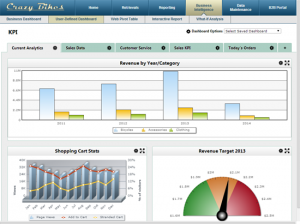 Summary: As we generate more data than ever before, Business Intelligence is becoming even more important. But–driven by recent trends–Business Intelligence is undergoing some major changes. Learn why, and what changes we can expect in the near future.
Summary: As we generate more data than ever before, Business Intelligence is becoming even more important. But–driven by recent trends–Business Intelligence is undergoing some major changes. Learn why, and what changes we can expect in the near future.
We’re in the middle of a data explosion. To what extent? Consider these statistics:

– According to stats mentioned in a recent study, data is growing by 40% every year.
– According to the same study, the amount of new data created on the web is doubling every two years.
– According to Eric Schmidt (former Executive Chairman of Google), every 2 days we create as much information as we did up until 2003.
But, it doesn’t stop there. Thanks to recent trends, the way we create data is also changing. The way we store and consume data is changing. The way we analyze data is changing.
What do all of these changes mean for business? As the amount of data we create grows, so does the need to capitalize on this data. But, the BI landscape is undergoing some major changes.
This begs the question: Where is BI heading? Today, let’s explore that question. Where is BI going in 2015 (and beyond)? What major trends are we seeing that we can expect next year? Here are 7 big BI trends to watch in 2015:
1. Intelligence comes from external data
In the past, BI was strictly internal. It provided key decision makers with a view of their internally-generated business data.
This is changing. External data is increasingly relevant to the business. For instance, would you like to know what people say about your company on social media? Would you like to know when competitors release news? Of course! Soon, we’ll see BI offering a mix of internal and external data and for sure market intelligence platform is a great solution.
“Traditionally, businesses leverage BI tools that utilize internal data to answer and inform internal business decisions,” says Brian Lichtenberger, Co-founder, 7Park Data. “The challenge is that many strategic business decisions require external marketplace data, forcing businesses to rely on surveys and market research. To gain more complete and accurate intelligence, businesses are increasingly leveraging cloud-based third-party analytics tools. These tools combine external data analysis and deep vertical domain knowledge–offering unique insights that are typically unavailable to businesses. We expect this trend to accelerate in 2015 as more businesses seek authoritative independent intelligence that is sourced from real data.”
2. Data becomes the trigger

Data is becoming more than fancy charts and graphs. It’s becoming an event trigger. When an event occurs, or when data reaches a certain threshold, it triggers an action.
How does this help? Here’s an example: What if your BI software sent an automated sms alert when sales dipped below a certain threshold? Or, what if your business leaders received alerts to dramatic, real-time shifts in data? In other words…what if your data was proactive?
We’re seeing this trend growing now, and will only gain steam in the coming year. As explained below, it’s even stretching beyond the business walls and into all aspects of your digital world.
“Automation software is growing in popularity these days, as people seek to tame the hassle of managing a varied and ever-growing range of content channels,” says Jeff Fernandez, CEO of Grovo. “My favorite app for this right now is IFTTT (short for “if this, then that” and pronounced like “gift”) which allows you to link tons of digital tools to one another. It’s easy: say you want every Instagram post that you tag with a certain keyword to be posted to your blog, too, and also shared on Twitter. You set up a simple chain of commands (“recipes” in IFTTT) and with one send button, share a post across three platforms. Non-social tools can be programmed too, like Dropbox and even the weather forecast.”
3. Predictive analytics gets democratized
Predictive analytics goes a step beyond traditional BI. Rather than telling you what happened in your business, predictive analytics looks toward the future. It tells you what will most likely happen in your business based on past data.
The problem: In the past, predictive analytics wasn’t for everyone. It was more complex than traditional BI. Many businesses didn’t have the resources to capitalize on it. But, that’s changing. As predictive analytics software grows simpler, we’ll see widespread adoption.
“I believe we’re going to see an evolution in accessibility as the science of data analytics progresses, and it’s going to affect the way you do business,” says Fernandez. “Predictive analytics is the ability to identify evidential, actionable signals for the future out of the torrential flow of data generated by every business. Good predictive analysis today is associated with huge salaries and proprietary algorithms. But, as those high-end analytics refine, predictive analytics suites will be as commonly used as Excel. Every business will be able to plan with the help of sci-fi caliber revenue predictions, market segmentation, and so on.”
4. Self-service BI becomes a ‘must-have’
 As mentioned earlier, we’re in the middle of a data explosion. What does this mean for business?
As mentioned earlier, we’re in the middle of a data explosion. What does this mean for business?
This means businesses must capitalize on their data. This means BI cannot be an “IT only” activity. It means the business can’t afford to wait days for reports, as was common in the past. This means end users must have access to self-service tools if a business hopes to compete in this data-driven era. Analytics must now permeate the entire business.
“Pressure on IT will increase as more and more users require analyzed data in their day-to-day activities,” says Ajeet Singh, CEO and Founder of ThoughtSpot. “Business users in every department will be impacted by the pressure to be “data driven” requiring a need for faster turnaround times for data analysis than IT can handle. Self-service analytics will become a “must have” instead of a “nice to have” in order to meet the needs of these increasingly data-driven organizations.”
5. BI tools deliver simplified user interfaces
We’re seeing two major trends impacting BI user interfaces.
First, mobile apps have changed user’s expectations. Users expect software to offer the same simplicity found in popular mobile apps. They expect to open new software and instantly understand how it works.
Secondly, attention spans are declining. Recent research finds that the average attention span has dropped from 12 seconds to 8 seconds since the year 2000. To put this in perspective, humans now have an attention span shorter than the average goldfish.
What does this mean? Simple user interfaces are becoming a necessity. Users will likely abandon the software if it doesn’t meet their expectations. They won’t take the time to figure it out, or read the instructions.
“This signals a shift in business technology as it will begin to look more like consumer and become available for use by more people within the organization,” says Singh. “Since people are accustomed to instantaneous results and interactive UIs, like they use in consumer tech, enterprise tools, like those used for BI, will have to trend in that direction in order to remain relevant.”
6. Integration becomes the name of the game

Data is moving outside of the business walls. As more businesses move some (or all) of their data to the cloud, BI becomes more complex.
BI will no longer be about pulling internal data together and presenting it in an understandable format. Integration will be the name of the game. How will you combine your internal data with external cloud data into meaningful management information?
“Personally, I believe data federation tools will see the most growth,” says Charles Settles, a Product Analyst at TechnologyAdvice. “Many companies are moving their infrastructure and operations to the cloud; these cloud-delivered data federation tools will allow them to pull data from disparate sources for in-memory processing at a fraction of the cost of traditional BI systems. A limiting factor will be the relative shortage of BI professionals, particularly Hadoop developers. Of course, if ‘self-service’ BI tools continue to grow, this will become less of an issue.”
7. Physical and digital worlds converge
As more and more physical objects connect to the web, BI is moving beyond the digital realm. It will capture far more than typical business data captured in the past. It will capture data from the physical world and merge that data with the digital. This is a BI trend that may not catch fire in 2015, but will certainly gain traction in the coming years.
“Hardware sensors produce real-time information about the physical world around them,” says Adam Roderick, CTO of eLine Technology. “As network-connected sensors are becoming more commonplace, we have an incredible amount of data on our hands about the real world—more so than we ever had in the digital world of web clicks and purchase transactions.”
So, what do you think? Is there anything you would add to this list? If so, please share your thoughts in the comments.
Pingback: 7 big Business Intelligence trends to watch in ...